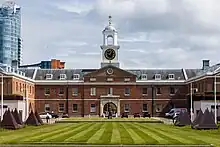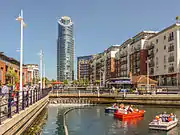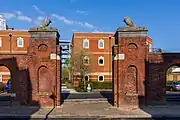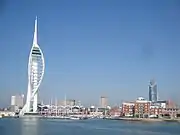 The East Plaza at Gunwharf Quays | |
| Location | Portsmouth, Hampshire, England |
|---|---|
| Coordinates | 50°47′42″N 1°06′21″W / 50.7949°N 1.1058°W |
| Owner | Land Securities |
| No. of stores and services | 93 plus a cinema, 25 pubs and restaurants |
| No. of floors | 2 |
| Website | gunwharf-quays |
Gunwharf Quays is a shopping centre located in the Portsea area of the city of Portsmouth in England. It was constructed in the early 21st century on the site of what had once been HM Gunwharf, Portsmouth. This was one of several such facilities which were established around Britain and the Empire by the Board of Ordnance, where cannons, ammunition and other armaments were stored, repaired and serviced ready for use on land or at sea. Later known as HMS Vernon, the military site closed in 1995, and opened to the public as Gunwharf Quays on 28 February 2001[1] after six years of reconstruction (which included the restoration of some of the surviving 18th and 19th-century Gun Wharf buildings). The landmark Spinnaker Tower, which stands close to the site on pilings in Portsmouth Harbour, was opened on 18 October 2005.[2]
History
.jpg.webp)
An Ordnance Yard (the Old Gun Wharf) was established on land reclaimed from the sea to the north of the old Mill Pond (which survives today as the canal) in 1706.[3] The site was extended by reclaiming further land from the sea to the south of the old Mill Pond to create the New Gun Wharf in circa 1800.[3] The Grand Storehouse (built as part the New Gun Wharf and now known as the Vulcan Building) was completed in 1814.[3]

A wide range of ordnance-related equipment had to be accommodated within the Yard. Gun carriages in particular took up a lot of space, and were prone to decay if left outside. Cannons and cannonballs, on the other hand, could be stored in the open air without too much damage being done, as described here in 1817:
Every ship in ordinary has on the wharf her guns, placed in regular rows, each ship's guns by themselves, with the name of the ship they belong to, painted in capital letters on the first gun of each parcel. The balls are formed in pyramids from 42 pounders to the lowest bores, every size in a pyramid by themselves; the bomb shells are also placed in the same regular order.[4]
In 1824 a set of storehouses along the southern edge of the site were converted to form barracks for the Royal Marine Artillery (the first time that this section of the Corps had been provided with its own separate barracks). In 1858 the Royal Marine Artillery moved out (first to Fort Cumberland, then to the new purpose-built Eastney Barracks);[5] Gunwharf Barracks were then given over to the Royal Artillery for a time,[6] after which they were occupied by the Army Ordnance Corps until 1891.[7]
The Grand Storehouse was mirrored by a similarly sizeable "Sea Service Store" on the Old Gun Wharf (later remodelled to serve as the Warrior naval accommodation block). In addition to these two, a plan dated 1859 indicates more than a dozen other large storehouses all around the site.[8]
As ships and armaments developed, the requirement to offload the armament diminished, and the Gunwharf fell into disuse. It re-established as the Royal Navy shore establishment HMS Vernon in 1923.[9] The site became HMS Nelson in 1986 and ceased operations in 1995.[5]
The site was then sold to Berkeley Group Holdings in 1996 and, after being redeveloped to a design by HGP Architects, re-opened as a retail outlet on 28 February 2001.[5] The 29 story largely residential tower No.1 Gunwhalf Quay was added to the site between 2008 and 2009.[10]
Retained historic buildings and structures

HMS Vernon suffered extensive damage during the Blitz, but a number of historic structures survived, some of which have been restored as part of the Gunwharf Quays development.
- The Old Customs House pub and restaurant, built as an administration block in the late 18th century, is the oldest building on the site and the only significant survival on the Old Gun Wharf side.[11]
- An early 19th-century gateway stands behind the Vulcan building, indicating the line of the original boundary of the New Gun Wharf;[12] Initially hemmed in by the fortifications of Old Portsmouth, the site expanded further when the town fortifications were levelled in the 1870s; much of the later perimeter wall, which dates from this expansion, remains in place around the edge of the site, along with the Main Gate of c.1870.[13]
- The Grand Storehouse (later called the Vulcan Building) was the principal structure on the New Gun Wharf, built 1811–14. Its north wing and clock tower were both destroyed in the Blitz and only reinstated as part of the Gunwharf Quays reconstruction.[14]
- The old Royal Marines Infirmary building was originally built as an Ordnance Storehouse at around the same time as the Vulcan block; together with other nearby storehouses it was converted to form Gunwharf Barracks, of which it is the only surviving part.[15]
- Behind the Vulcan building, and dwarfed by it, is a former shell store (Building No. 25) dating from 1856.[14]
 Canalside looking towards the Plaza. The small roofed building right of centre was a guardhouse for the bridge which linked the two halves of the site.
Canalside looking towards the Plaza. The small roofed building right of centre was a guardhouse for the bridge which linked the two halves of the site._-_2023-04-21.jpg.webp) Ordnance Yard administration block (1770s)
Ordnance Yard administration block (1770s) Former gatehouse and perimeter wall (1870s)
Former gatehouse and perimeter wall (1870s).jpg.webp) Lodge and guardhouse inside the Main Gate
Lodge and guardhouse inside the Main Gate Former Royal Marine Infirmary (c.1814) within the perimeter wall
Former Royal Marine Infirmary (c.1814) within the perimeter wall 19th-century gateway located behind the Vulcan Building
19th-century gateway located behind the Vulcan Building Quayside crane
Quayside crane Preserved figurehead from HMS Marlborough, which latterly served as an accommodation hulk for HMS Vernon
Preserved figurehead from HMS Marlborough, which latterly served as an accommodation hulk for HMS Vernon Figurehead from the original (1832) ship HMS Vernon
Figurehead from the original (1832) ship HMS Vernon Gunwharf Quays viewed from the water
Gunwharf Quays viewed from the water
See also
References
- ↑ "New era dawns for Portsmouth as Gunwharf quays opens". The News. Portsmouth. 15 February 2016.
- ↑ "History & Construction". Emirates Spinnaker Tower.
- 1 2 3 "The Origins of Gunwharf and HMS Vernon". History in Portsmouth. Retrieved 12 July 2019.
- ↑ Allen, Lake (1817). The History of Portsmouth. London: Hatfield & co.
- 1 2 3 Groombridge, Garth (2017). Portsmouth in 50 Buildings. Amberley Publishing. ISBN 978-1445664064.
- ↑ The New Portsmouth Guide, Containing a Full Description of the Island and Its Environs, Together with the Dock-yard, Gun-wharf, and Royal Clarence Victualling Establishment (11th ed.). Portsmouth: William Henry Charpentier. 1860. p. 68.
- ↑ Underwood, Michael (2015). Gunwharf Quays: The History, Architecture, Conservation and Development of a Remarkable Military Site. Portsmouth: Tricorn Books.
- ↑ "Plan of Gunwharf 1859". Minewarfare & Clearance Diving Officers' Association.
- ↑ "HMS Vernon". Retrieved 7 April 2017.
- ↑ O’Brien, Charles; Bailey, Bruce; Pevsner, Nikolaus; Lloyd, David W. (2018). The Buildings of England Hampshire: South. Yale University Press. p. 506. ISBN 9780300225037.
- ↑ Historic England. "HMS Nelson; Building number 58 (1245373)". National Heritage List for England. Retrieved 1 October 2015.
- ↑ Historic England. "Former Gunwharf Gateway and walls of approximately 3 meters to north 38 meters to south (1378580)". National Heritage List for England. Retrieved 1 October 2015.
- ↑ Historic England. "Perimeter walls with gateways including former main gate and lodges (1333204)". National Heritage List for England. Retrieved 1 October 2015.
- 1 2 Historic England. "Vulcan Block (Building number 21) and attached bollards (1104329)". National Heritage List for England. Retrieved 1 October 2015.
- ↑ Historic England. "Building number 47 (The Royal Marines Infirmary) (1378579)". National Heritage List for England. Retrieved 1 October 2015.